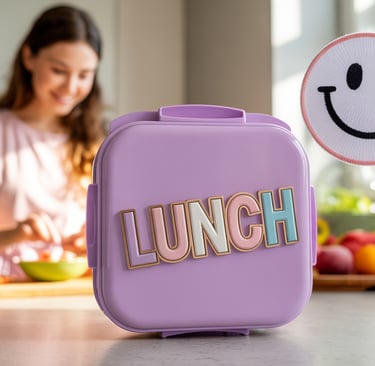Lunchbox Safety Tips for Parents: Keep Your Child’s Food Safe & Fresh
Packing a lunchbox is part of many parents’ daily routine, but keeping food safe until lunchtime is just as important as making sure it’s healthy and tasty. Warm classrooms, long bus rides, and busy schedules can all increase the risk of foodborne illnesses if lunchboxes aren’t packed and handled properly. Here are practical, science-backed food safety tips every parent should know when packing a safe lunchbox for school, summer camps, or outings.
7/3/20253 min read


1. Start with Clean Hands & Tools
It may sound basic, but handwashing is the first defense against bacteria. Always wash your hands thoroughly before preparing your child’s lunch.
Clean all surfaces, knives, containers, and cutting boards before using them, especially when switching from raw foods (like meat or eggs) to ready-to-eat items like sandwiches or fruits.
2. Choose the Right Lunchbox
Look for:
Insulated lunch bags to help maintain safe temperatures.
Easy-to-clean interiors (wipe them daily!).
Lunchboxes with room for an ice pack.
Hard plastic lunchboxes or bags with a wipeable lining are easier to sanitize than cloth bags.
3. Keep Cold Foods Cold
Cold foods should stay below 5°C (41°F) to slow bacteria growth. Use:
Ice packs or a frozen water bottle inside the lunchbox.
Insulated containers for items like yogurt or pasta salad.
Frozen fruits or smoothies—they’ll thaw by lunchtime and help keep other items cool.
If your child has a fridge at school, remind them to place their lunch there. Otherwise, pack cold foods with enough insulation to stay cold for several hours.
4. Keep Hot Foods Hot
For soups, pasta, or leftovers, use an insulated food jar (thermos).
Heat the food to steaming hot (above 74°C / 165°F) before placing it in the container.
Fill the thermos with boiling water for a few minutes to pre-warm it, then add the hot food.
Hot foods should stay above 60°C (140°F) to remain safe.
5. Pack Perishables Carefully
Some foods spoil quickly if left at room temperature:
⚠️ Cheese, deli meats, cut fruit, eggs, yogurt, hummus, cooked pasta, and rice.
If you include these, always use an ice pack. Alternatively, choose shelf-stable snacks like:
✔️ Nut butters (if allowed)
✔️ Dried fruits
✔️ Whole fruits with peel (apples, bananas, mandarins)
✔️ Whole grain crackers
✔️ Trail mix (nut-free for allergy-safe schools)
6. Wash Fruits & Veggies Thoroughly
Even fruits with peel (bananas, oranges) can transfer dirt and bacteria when peeled. Wash all produce under running water, scrubbing firm-skinned fruits. Pat them dry before packing.
Pre-cut fruits and vegetables should be stored in clean containers in the fridge until ready to pack.
7. Avoid High-Risk Foods
Some foods are more prone to bacteria growth and may not be safe in a lunchbox without strict temperature control. Try to avoid:
🚫 Raw or undercooked eggs (no homemade mayonnaise)
🚫 Sushi or raw fish
🚫 Unpasteurized dairy products
🚫 Rare meats
8. Keep Lunchbox Items Separated
Use separate containers for wet and dry items.
Put juicy fruits in leak-proof containers.
Wrap sandwiches separately from fruits to avoid soggy bread.
Reusable silicone bags, bento boxes, and individual snack containers can help keep foods fresh and safe.
9. Teach Your Child Basic Safety Habits
Even young children can learn:
✔️ Wash hands before eating.
✔️ Keep their lunchbox closed when not eating.
✔️ Throw away uneaten perishable food after lunch (don’t save it for later).
✔️ Don’t share food with friends (helps prevent spreading germs).
10. Clean the Lunchbox Daily
Wash the lunchbox, containers, and water bottles every day with hot, soapy water. Allow them to air dry completely before packing the next day.
Check for spills or crumbs that can attract mold or bacteria over time.
Quick Lunchbox Safety Checklist for Parents:
✔️ Washed hands before preparing food
✔️ Clean lunchbox & containers
✔️ Ice pack used for cold foods
✔️ Thermos for hot foods, preheated and filled with steaming-hot food
✔️ All produce washed and dried
✔️ No high-risk foods packed
✔️ Lunchbox cleaned at the end of the day
🌟 Bonus Tip: Involve Your Child
Kids love to help—and they’re more likely to follow safety habits if they’re involved. Let them:
Wash and pack their own fruits.
Place the ice pack in the lunchbox.
Choose their water bottle and help wash it each day.
A healthy lunch keeps your child energized for the school day—but a safe lunch keeps them healthy in the long run. With a few simple habits, you can help prevent foodborne illnesses and give your child a lunch that’s both delicious and safe to eat.
Join us on Pinterest
letstalk@lorybs.com
© 2025. All rights reserved.
